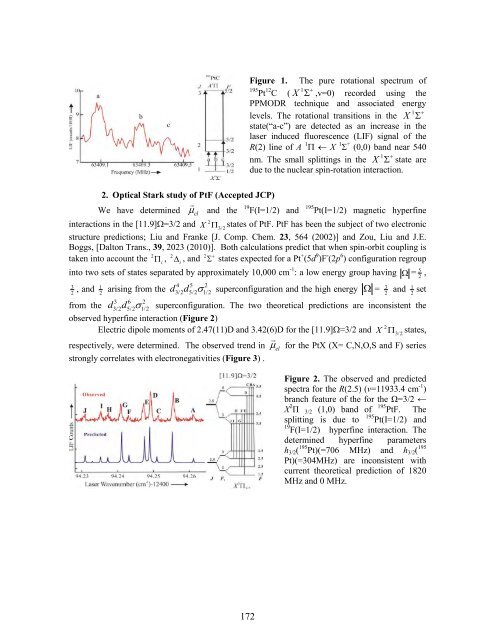Eighth Condensed Phase and Interfacial Molecular Science (CPIMS)
Eighth Condensed Phase and Interfacial Molecular Science (CPIMS)
Eighth Condensed Phase and Interfacial Molecular Science (CPIMS)
Create successful ePaper yourself
Turn your PDF publications into a flip-book with our unique Google optimized e-Paper software.
2. Optical Stark study of PtF (Accepted JCP)<br />
Figure 1. The pure rotational spectrum of<br />
195 12 1<br />
Pt C ( X �<br />
� ,v=0) recorded using the<br />
PPMODR technique <strong>and</strong> associated energy<br />
1<br />
levels. The rotational transitions in the X �<br />
�<br />
state(“a-c”) are detected as an increase in the<br />
laser induced fluorescence (LIF) signal of the<br />
R(2) line of A 1 � � X 1 � + (0,0) b<strong>and</strong> near 540<br />
1<br />
nm. The small splittings in the X �<br />
� state are<br />
due to the nuclear spin-rotation interaction.<br />
� <strong>and</strong> the 19 F(I=1/2) <strong>and</strong> 195 Pt(I=1/2) magnetic hyperfine<br />
We have determined el<br />
2<br />
interactions in the [11.9]�=3/2 <strong>and</strong> X � states of PtF. PtF has been the subject of two electronic<br />
3/2<br />
structure predictions; Liu <strong>and</strong> Franke [J. Comp. Chem. 23, 564 (2002)] <strong>and</strong> Zou, Liu <strong>and</strong> J.E.<br />
Boggs, [Dalton Trans., 39, 2023 (2010)]. Both calculations predict that when spin-orbit coupling is<br />
taken into account the 2<br />
� , 2<br />
2 �<br />
� , <strong>and</strong> � states expected for a Pt + (5d 9 )F - (2p 6 ) configuration regroup<br />
i i<br />
into two sets of states separated by approximately 10,000 cm -1 : a low energy group having � = 5<br />
2 ,<br />
3 1 , <strong>and</strong> 2 2<br />
from the<br />
arising from the<br />
4 5 2<br />
d3/2d5/2� 1/2 superconfiguration <strong>and</strong> the high energy � = 3<br />
2<br />
<strong>and</strong> 1<br />
2 set<br />
3 6 2<br />
d3/2d5/2� 1/2 superconfiguration. The two theoretical predictions are inconsistent the<br />
observed hyperfine interaction (Figure 2)<br />
2<br />
Electric dipole moments of 2.47(11)D <strong>and</strong> 3.42(6)D for the [11.9]�=3/2 <strong>and</strong> X � states,<br />
respectively, were determined. The observed trend in � el for the PtX (X= C,N,O,S <strong>and</strong> F) series<br />
strongly correlates with electronegativities (Figure 3) .<br />
172<br />
3/2<br />
Figure 2. The observed <strong>and</strong> predicted<br />
spectra for the R(2.5) (v=11933.4 cm -1 )<br />
branch feature of the for the Ω=3/2 ←<br />
X 2 Π 3/2 (1,0) b<strong>and</strong> of 195 PtF. The<br />
splitting is due to 195 Pt(I=1/2) <strong>and</strong><br />
19 F(I=1/2) hyperfine interaction. The<br />
determined hyperfine parameters<br />
h3/2( 195 Pt)(=706 MHz) <strong>and</strong> h3/2( 195<br />
Pt)(=304MHz) are inconsistent with<br />
current theoretical prediction of 1820<br />
MHz <strong>and</strong> 0 MHz.
















